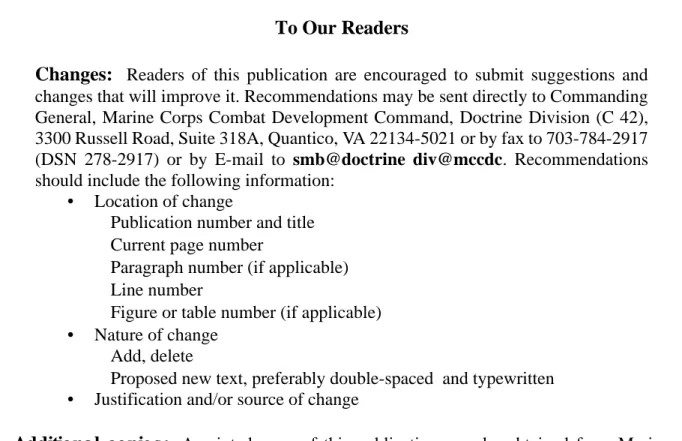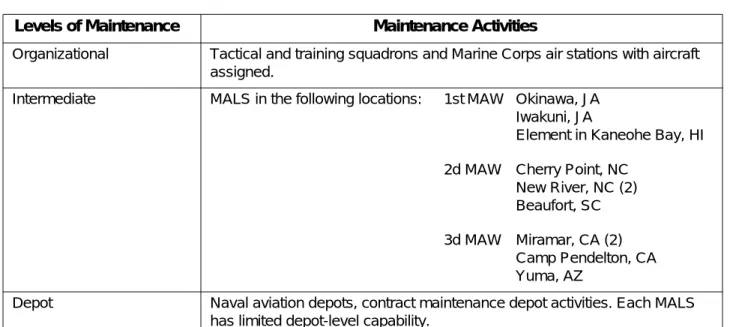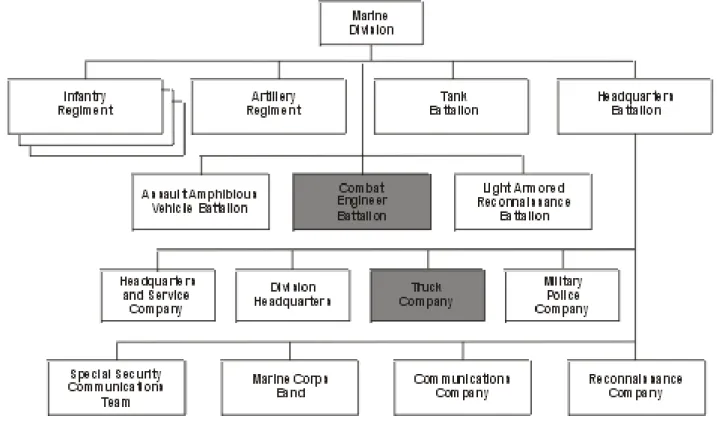It addresses the Marine Corps' core logistics capabilities at the strategic, operational, and tactical levels of war. Marine Corps operational forces, assisted by headquarters, the Marine Corps, and the supporting establishment, are responsible for operational logistics.
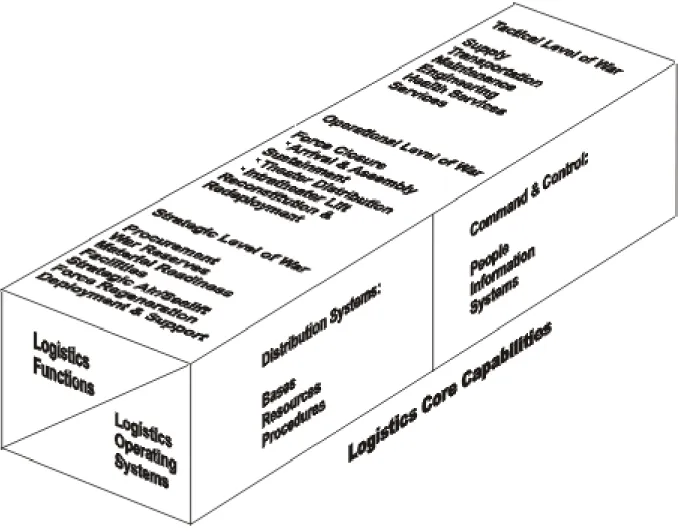
1005. Principles of Logistics Support
Availability (or adequacy) is the ability to provide the minimum, essential supplies and services required to initiate combat operations. Sustainability is the ability to maintain logistical support for all users in the entire operational area during the operational period.
1006. Functional Areas of Marine Corps Logistics
Endurance focuses the commander's attention on long-term force objectives and capabilities. Intermediate—Performed by designated agencies in support of the unit of use or, for some designated equipment, by units specifically authorized for use.
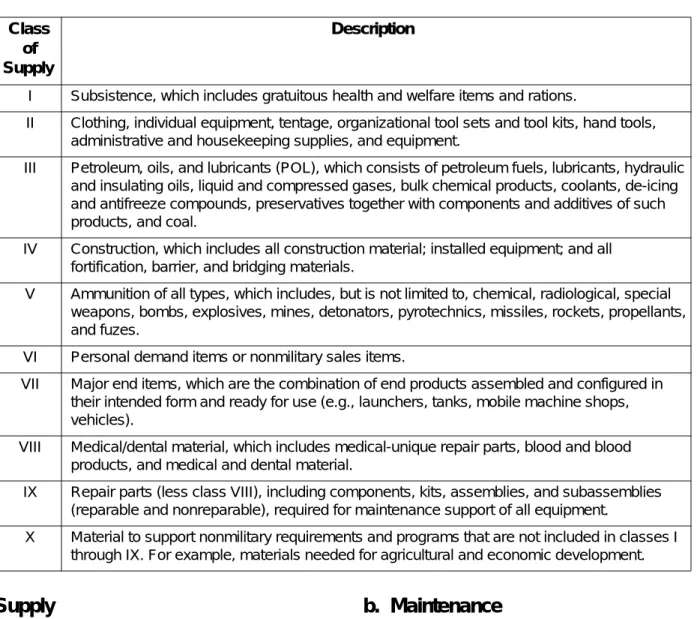
Marine Corps Logistics Responsibilities and Organization
2001. Logistics Responsibilities
As a member of the Joint Chiefs of Staff, the commander ensures that the Marine Corps—. Commanders in the Marine Corps operational forces, support establishment, and reserve delegate authority for logistical matters to designated subordinates.
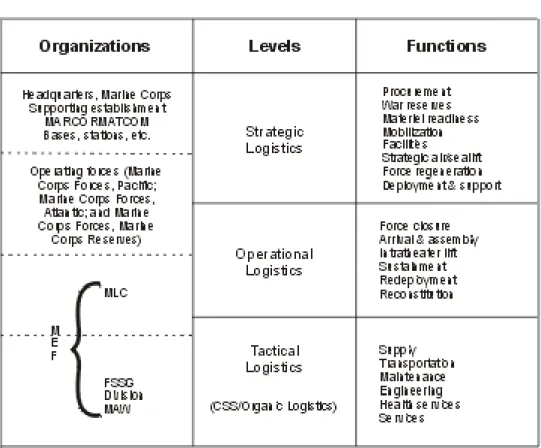
2002. Command Relationships and Other Authorities
Commanders in the Armed Forces Operations and Marine Corps Reserve normally exercise OPCON over subordinate organizations through established command structures. The Marine Corps administrative control channel runs from the Commandant to all sub-commanders in the operational forces, the Marine Reserve Corps, and the support establishment.
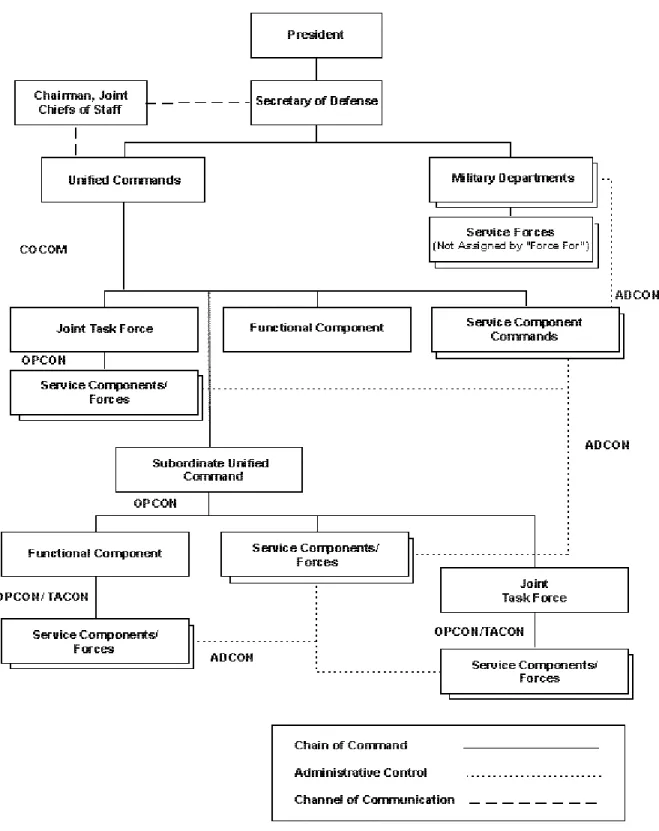
2003. Headquarters, Marine Corps
The Department of Programs and Resources has various responsibilities for developing the combat capabilities of the Marine Corps. He is responsible for generating the Marine Corps portion of the biennial Department of the Navy Program Objective Memorandum (POM) in the PPBS.
2004. Staff Cognizance and Logistics Support
The planning, programming, and budgeting system governs both Marine Corps logistical support requirements (based on the funded levels of forces and equipment) and logistical capabilities (based on authorized levels of funding for operations and maintenance, forces and equipment). is supported). Organizations' G-3/S-3 provide ground-common or aviation-specific logistics support to other organizations' plans and oversee logistics support operations. l Coordinate with the G-3/S-3 of supporting organizations during the development of their concepts of operations and maneuvering plans to ensure they are supported. l Coordinate with both the G-3/S-3 and G-4/S-4 of supported organizations to identify logistical support requirements and develop support capability estimates for their operational concepts. l Recommending the composition and organization of support organizations based on guidance from senior headquarters and the concepts of operation and maneuvering schedules of support organizations. l Coordinating and supervising the execution of the command's logistic support operations and providing liaison elements to the support commands.
2005. Operating Forces
Regardless of command level, the Marine Corps Component Commander deals directly with the Joint Force Commander on matters affecting assigned Marine Corps forces. The Marine Corps component commander is responsible for training, equipping, and supporting the Marine Corps forces assigned to the joint force.
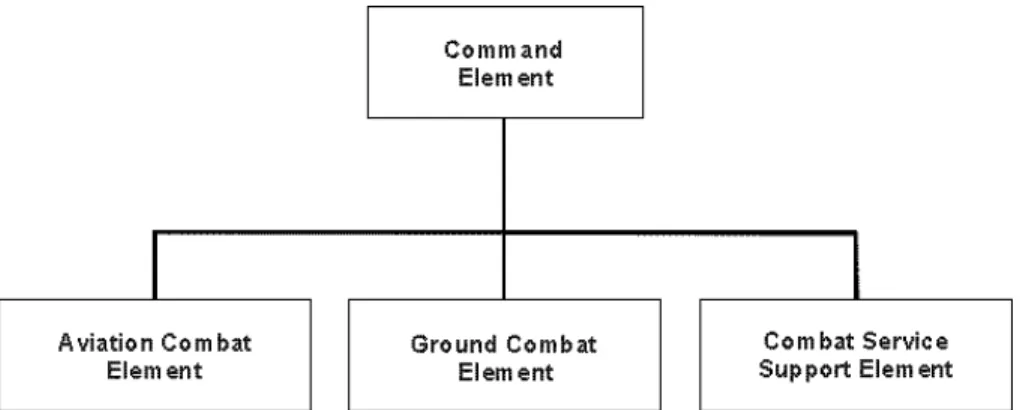
2006. Marine Corps Reserve
2007. Supporting Establishment
Service-level supply and maintenance support for the Marine Corps and some support services for DOD. Marine Corps Logistics Base Albany is the inventory control point for the Marine Corps supply system. Department of the Navy Agencies Several Department of the Navy agencies support both the Navy and the Marine Corps.
2008. War Materiel Support
Peacetime stockpiles are on-hand inventories that support the day-to-day operational and training requirements of the operational forces and the Marine Corps Reserve. Inventory control point (WRM) inventories is the portion of WRM inventories held at the wholesale level at Marine Corps logistics bases or in the . Programming and budgeting for WRM supplies (field) is the responsibility of the respective force or activity commander of the Marine Corps who maintains assets on responsible records.
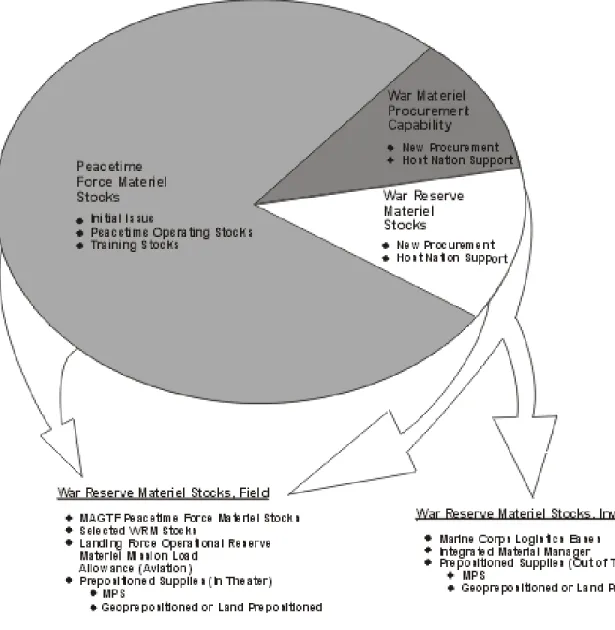
Command and Control of Logistics
3001. Command and Control Organization and Architecture
To coordinate interrelated PDE&A cycles, planners must therefore be flexible - form should not be rigidly enforced at the expense of effectiveness. A continuous flow of information between all command echelons and functional activities and the exchange of liaison officers facilitates communication and increases PDE&A cycles. Logisticians also use the PDE&A cycle to schedule support during expected breaks instead of creating breaks to provide support; this allows the supported commander to maximize pace.
3002. Command and Control Organizations and the Levels of
The command and control systems that support logistics operations provide logisticians with the means to carry out these tasks. Command and control of logistics at the tactical level focuses on monitoring, directing and executing logistics operations and maintaining communications with supporting forces at the operational level. The Aviation Logistics Department of ACE works with MALS to address deficiencies in aviation logistics.
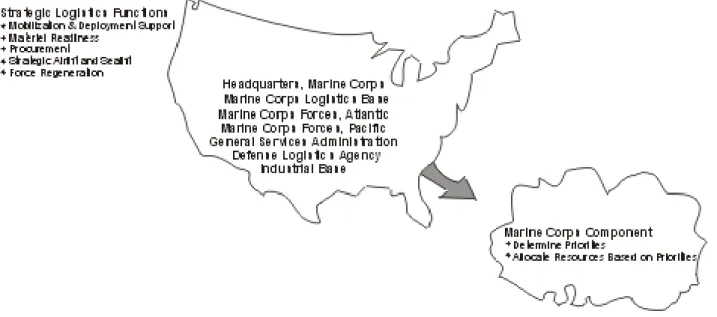
3003. Command and Control Information Systems
TC-AIMS and ATLASS will be the primary systems providing functional logistics management for maintenance and distribution. Provides automated information processing support for supply, financial and organizational maintenance management to MWSG and MALS. Provides automated information processing support for the maintenance of all aviation equipment and spare parts for aviation units (MWSG and MALS) and selected base and garrison activities throughout the Marine Corps.
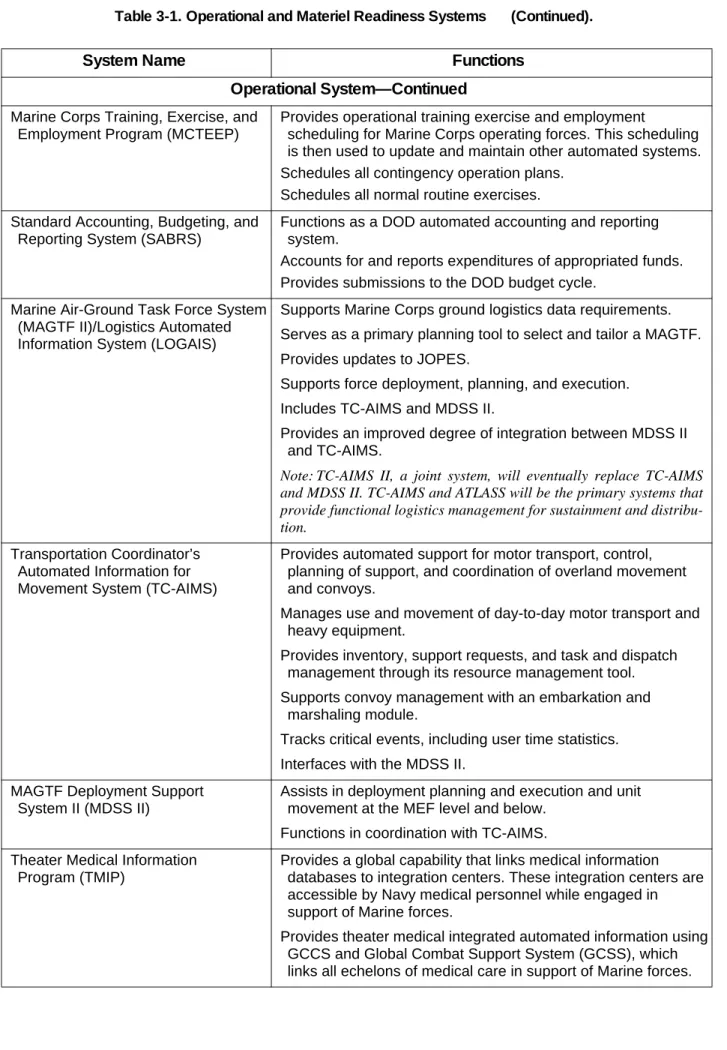
3004. Information Management and Technology Improvements
For information technology to support logistics command and control, planners need a means by which information is accessible, shared, standardized, and timely for all users of the model. The Common Data Environment has become a Department of Defense initiative and a central focus of information technology supporting logistics command and control. Automated identification technology supports logistics command and control by ensuring the speed and accuracy of data collection and entry.
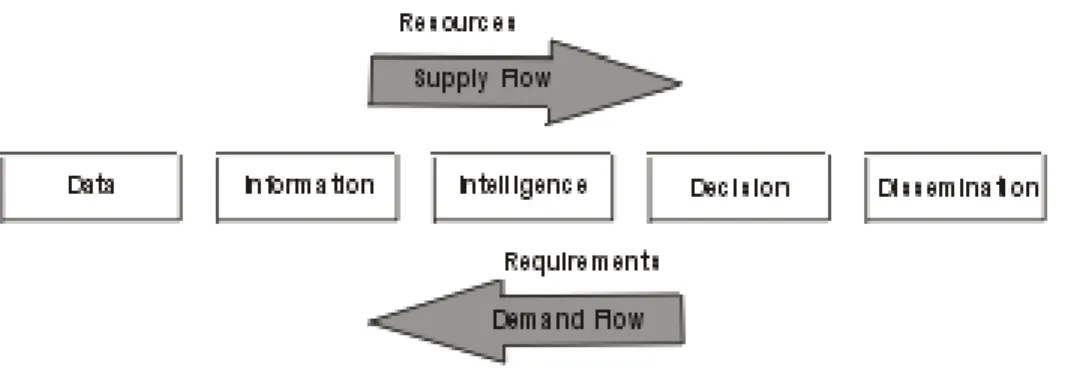
3005. Considerations for Joint or Multinational Command and
Logistics Planning
4001. Planning at the Levels of War
Marine organizations use the Marine Corps Planning Process (MCPP) to prepare their plans and orders, as well as Marine Corps input to JOPES.
4002. Administrative and Operational Planning
4003. Planning for Resources
4004. Principles and Considerations
The distribution system is the pipeline through which supplies and services flow from the supporting command to the supported command. Support forces must be able to regulate the flow of supplies and services to expedite critical supplies and services as needed. Supported commanders and their staffs integrate requirements and capabilities during planning and participate in controlling the flow of supplies and support services during execution.
4005. Mission and Task Analysis
As procurement actions are carried out, goods and services begin to flow, and eventually the flow reaches a state corresponding to expenditure. Accompanying supplies and services must be sufficiently large and the timing of requisitions must be anticipated so that capabilities overlap or at least cover requirements throughout the run time. Control measures should allow for the accumulation of lower-priority supplies and services at holding points or their distribution to forces that have higher priorities.
4006. Factors Affecting Logistics Planning
Experience and Intuitive Analysis Commanders and logisticians must apply judgment based on experience and sound personnel work to assess risk and ensure that a proposed solution to a support problem is both feasible and practical.
4007. Coordination in Planning
4008. Planning Systems
A specific product of the JSPS process is the Joint Strategic Capabilities Plan, which is the main document used by combatant commanders and service chiefs to perform military tasks in a short period of time (2 years). PPBS is the system used by DOD and service schedulers to allocate DOD funds to the requirements generated by JSPS. GCCS (see Fig. 4-2), discussed in more detail in Chapter 3, is a C2 system that provides JOPES capabilities and facilitates the deployment and redeployment of Marine Corps troops.
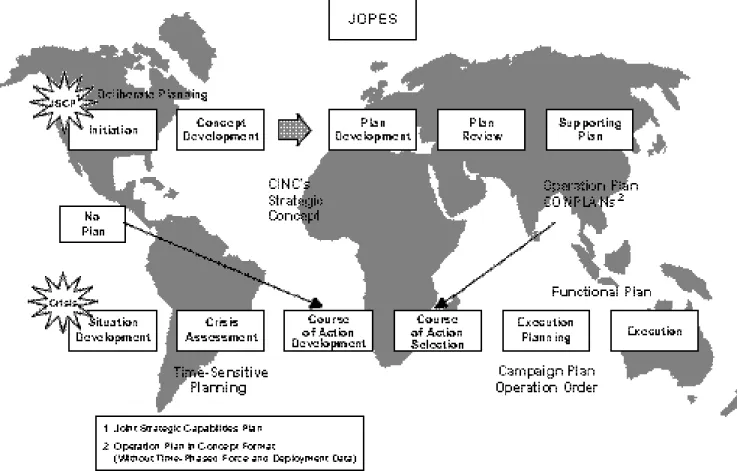
4009. Planning Procedures
In particular, the Marine Corps Tactical Combat Operations System facilitates MAGTF planning and employment under JOPES. Marine Corps and MAGTF forces prepare inputs for operational plans and support plans in deliberate and time-sensitive planning modes. The MCPP is the standard Marine Corps force planning procedure, or MAGTF, tailored to the Marine Corps warfighting philosophy.
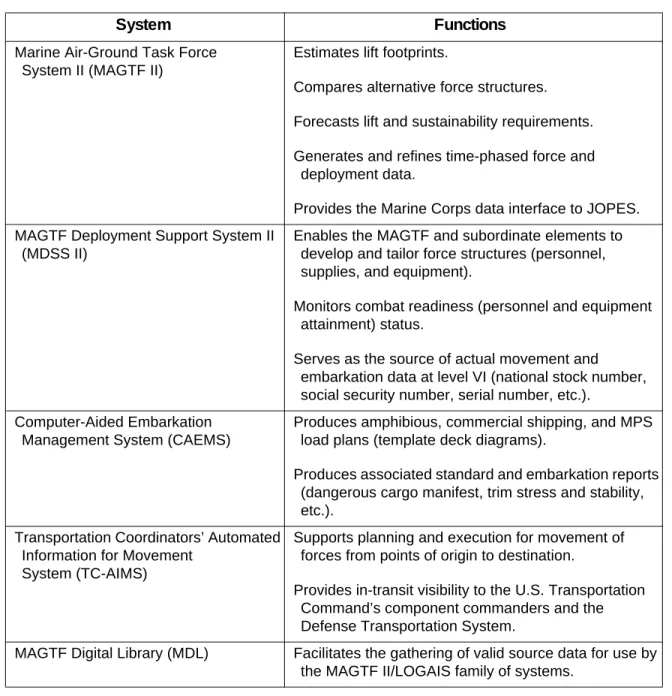
Logistics Execution
5001. Expeditionary Operations
5002. Predeployment Actions
The ability to meet these requirements will determine whether activation of the Marine Corps Reserve is necessary. The execution of any major operational plan requires augmentation and reinforcement by the Marine Corps Reserve. The equipment is returned to the control of the commanding officer, Marine logistics base, inventory control point.
5003. Deployment
The force movement control center allows the commander, Marine Corps forces, and the MEF commander to control and coordinate all deployment activities. The Force Movement Control Center directs all deployment support activities in the division; MAW; FSSG;. The Logistics Movement Control Center can be extended by base, station, host nation or other organizations.
5004. Entry
Termination of the MPF operation occurs when all the prerequisites in the initiation directive are met, and the MAGTF is established ashore. The movement phase consists of the movement of forces by air and sea to the arrival and assembly area. An MPF operation is a logistics operation because it involves deployment and preparation of the MAGTF for employment.
5005. Enabling and Decisive Actions
DACG and AACG coordinate with TALCE and/or ACE as needed to ensure smooth operations. Movement officers must coordinate receipt of equipment and arrival of accompanying personnel and equipment with AACG. They also enable the fulfillment of non-combat tasks in accordance with the commander's concept of operation.
5006. Power Projection From the Sea and Amphibious Operations
Logistics support operations that support enabling and decisive actions enhance the commander's ability to influence the battle and affect the combat power of the MAGTF. The buildup of logistics ashore requires a beach support area developed by the landing support element. MAGTFs embarking on amphibious ships are capable of conducting LOTS operations in support of the MAGTF.
5007. Redeployment
Another important factor is the degree of enemy resistance; large concentrations of materiel and equipment ashore can be vulnerable targets, the destruction of which could seriously impair the supported operation. The shore support area allows initial accumulation of sustainment ashore and subsequent establishment of a CSS area providing sustained support to the landing force. Doctrine for joint LOTS operations and some specialized equipment has been developed for LOTS operations involving Army units and equipment in addition to Marine Corps and Navy units and equipment.
5008. Joint or Multinational Operations
Emerging Concepts
Operational Maneuver From the Sea
Subsequent improvements in the MPS and in the organization of the MPF now provide an opportunity for instream download. The use of MPF forces in the assault phase of the amphibious operation would involve a dangerous improvisation. Furthermore, the MPF must be able to integrate into an amphibious operation or ride on the heels of the amphibious force ashore.
Sustained Operations Ashore
The logistics operations center would be activated during transit to the area of operation. To address this need, the Marine Logistics Command concept is being examined to support shutdown, force sustainment, and reconstruction and redeployment functions. Marine Logistics Command then focuses on general support missions and interaction with other theater logistics agencies as they arrive.
Implications of Emerging Concepts
The role of the Naval Logistics Command during the deliberate planning phases of operational planning would be to support the identification, preparation, and delivery of host nation and inter-service support and inter- and inter-theater requirements for the Naval Service component. The FSSG, designated as the Maritime Logistics Command, deploys early and provides support for the arrival, assembly, and initial missions of the CSS in the MEF until its CSSE is established. While it may initially be tasked to provide a lesser degree of support to the other Services, it is not envisaged (because of its limited capabilities) that the Naval Logistics Command will assume the role of permanent theater support agency in a theater of baked.
Acronyms
